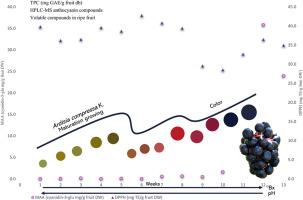Maturation of Ardisia compressa K. fruit: A comprehensive study on phenolic potential, physicochemical characterization, and volatile compounds for the determination of optimal harvest time
IF 2
4区 生物学
Q4 BIOCHEMISTRY & MOLECULAR BIOLOGY
引用次数: 0
Abstract
Capulin (Ardisia compressa K.) is a purple fruit consumed fresh and widely used in tropical cuisine. While studies have highlighted its phenolic potential at harvest, they have often overlooked the quality parameters that determine optimal harvest timing. This research aimed to assess the evolution of phenolic compounds, physicochemical properties, and chromatic changes in capulin fruits to establish the ideal harvest time. HPLC-MS analysis revealed that anthocyanin levels peaked at the final stages of maturation, with malvidin 3-O-galactoside and petunidin 3-O-galactoside showing the greatest increases. Total monomeric anthocyanins accumulated, reaching their highest concentrations in the last three weeks, while total phenolics and antioxidant activity fluctuated. Fruit size and weight increased weekly, accompanied by rising soluble solids and decreasing pH. CIELAB color analysis showed declining L∗ and b∗ values, while a∗ values increased until week 10 before slightly decreasing. Additionally, volatile compound analysis during the maturation phase identified 123 volatile compounds, with 71.80 % classified as terpenes, contributing to the fruit's aromatic profile, with caryophyllene accounting for 65.44 % of them. This study highlights the dynamic evolution of phenolic compounds, physicochemical properties, and chromatic changes in capulin fruits throughout ripening, emphasizing that the optimal harvest time occurs at the end of maturation when phenolic potential is highest.

压缩紫荆果实的成熟:酚势、理化特性和挥发性化合物的综合研究,以确定最佳采收期
卡普林(Ardisia compressa K.)是一种新鲜食用的紫色水果,广泛用于热带美食。虽然研究强调了其在收获时的酚潜力,但他们往往忽视了决定最佳收获时间的质量参数。本研究旨在通过对甜椒果实中酚类化合物、理化性质和颜色变化的研究,确定甜椒果实的理想收获期。HPLC-MS分析显示,花青素含量在成熟后期达到峰值,其中锦葵苷3- o -半乳糖苷和矮花菊苷3- o -半乳糖苷的含量增幅最大。总单体花青素积累,在最后三周达到最高浓度,而总酚类物质和抗氧化活性波动。果实大小和重量随周增加而增加,可溶性固形物增加,ph值降低。CIELAB颜色分析显示L∗和b∗值下降,而a∗值上升,直到第10周才略有下降。此外,成熟期挥发性化合物分析鉴定出123种挥发性化合物,其中71.80%归类为萜烯,对果实的芳香特征有贡献,其中石竹烯占65.44%。本研究重点分析了甜橘果实中酚类化合物、理化性质和颜色变化在整个成熟过程中的动态演变,强调了甜橘果实中酚类电位最高的成熟末期是最佳采收期。
本文章由计算机程序翻译,如有差异,请以英文原文为准。
求助全文
约1分钟内获得全文
求助全文
来源期刊

Biochemical Systematics and Ecology
生物-进化生物学
CiteScore
3.00
自引率
12.50%
发文量
147
审稿时长
43 days
期刊介绍:
Biochemical Systematics and Ecology is devoted to the publication of original papers and reviews, both submitted and invited, in two subject areas: I) the application of biochemistry to problems relating to systematic biology of organisms (biochemical systematics); II) the role of biochemistry in interactions between organisms or between an organism and its environment (biochemical ecology).
In the Biochemical Systematics subject area, comparative studies of the distribution of (secondary) metabolites within a wider taxon (e.g. genus or family) are welcome. Comparative studies, encompassing multiple accessions of each of the taxa within their distribution are particularly encouraged. Welcome are also studies combining classical chemosystematic studies (such as comparative HPLC-MS or GC-MS investigations) with (macro-) molecular phylogenetic studies. Studies that involve the comparative use of compounds to help differentiate among species such as adulterants or substitutes that illustrate the applied use of chemosystematics are welcome. In contrast, studies solely employing macromolecular phylogenetic techniques (gene sequences, RAPD studies etc.) will be considered out of scope. Discouraged are manuscripts that report known or new compounds from a single source taxon without addressing a systematic hypothesis. Also considered out of scope are studies using outdated and hard to reproduce macromolecular techniques such as RAPDs in combination with standard chemosystematic techniques such as GC-FID and GC-MS.
 求助内容:
求助内容: 应助结果提醒方式:
应助结果提醒方式:


